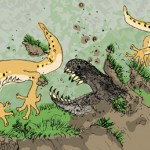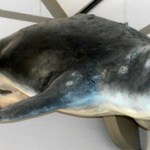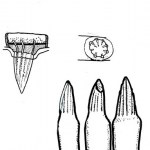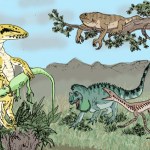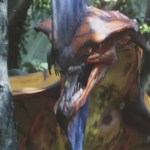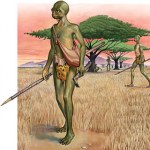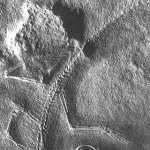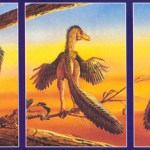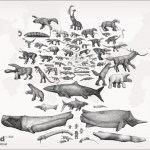speculative zoology
When unable to find time to do anything else, resort to posting Squamozoic sneak-peeks (previous example here)...
This scene - 'Riverbank ambush' - features a giant macro-predatory amphisbaenian and some surprised gekkotans. Colouring by Tim Morris. Feel free to discuss among yourself. Kinda busy right now...
I've just spent a few days at the Institut royal des Sciences naturelles de Belgique in Brussels, for theropod-related reasons. A great museum, with tons of excellent material on display. I just want to briefly report one interesting discovery here: I was surprised and delighted to find that the recently opened Gallery of Evolution includes a small selection of hypothetical future animals, apparently the inhabitants of the Dixonian epoch. Here's my favourite beast...
It's the giant penguin Neopygoscelis dentatus, though I didn't know this when I was looking at it: I wondered whether it might…
I recently posted an updated version of the 'Science of Godzilla' article, and what a great success it was. But I'm kicking myself, because I totally forgot something else I should have mentioned: Tracy L. Ford recently had cause to produce a number of anatomical drawings of Zilla (aka GINO*/Deanzilla/Fraudzilla), the monster bipedal reptile that invades New York in the 1998 TriStar movie Godzilla. Like all Godzilla fans, I don't regard Zilla as a 'Godzilla' at all; rather, it's a charlatan, an imposter. And the movie itself is awful.
* Godzilla In Name Only
Anyway, Tracy has been kind…
The time has come to recycle this Tet Zoo classic, dating to February 2007 (it's actually one of the oldest of Tet Zoo ver 2 articles). I've updated it a bit and have included new pics - enjoy! [image below from Kaiji anatomical drawings.. read on for discussion].
To begin with, let's get things straight and admit up front that Godzilla is not a real animal, nor was it ever. It's an unfeasibly big late-surviving dinosaur (belonging to the hypothetical taxon Godzillasaurus, according to some), mutated by radiation, with a radioactive heart. Godzilla is virtually impervious to other gigantic…
Tone and I recently went to see Avatar. I've been reading up on the movie for months and was really looking forward to seeing it. I mostly liked it, though did think it was a bit clichéd and predictable. But I'm not here to talk about storylines and plot devices... you want to know about the creatures. A lot of thought and time obviously went into the design of Pandora's ecosystem and creatures. In part, I'd say that this was a success: a lot of people (even many not that interested in the natural world) have been very much taken in by the movie's xenobiology - if only this inspired them to…
Regular readers will know that I'm not exactly a fan of the idea - discussed here and there in the technical (Russell & Séguin 1982, Russell 1987), popular (Hecht 2007, Socha 2008, Naish 2008) and speculative literature (McLoughlin 1984, Magee 1993) - that non-avian theropod dinosaurs might have evolved into humanoids had they not bought the farm 65 million years ago [image below by Matt Collins].
The hypothetical (emphasis: hypothetical) evolution of big brains, intelligence and so on among imaginary post-Cretaceous deinonychosaurs is not (in my opinion) all that unreasonable, and I…
In the previous article we looked at the Birds Come First, or BCF, hypothesis. It goes without saying that BCF has not won acceptance in the community, nor - in fact - is it even familiar to the majority of archosaur workers. Here, we take a critical view of BCF: does it stand up, or does it fail?
To begin with, let me note that the underlying premise of BCF is fundamentally problematical: the idea that there is some sort of 'central trunk' (Olshevsky 1994, p. 42) or single, unbroken lineage that extended from the first stem-archosaur to the most recently evolved, modern bird. Old 'family…
A substantial amount of evidence demonstrates that birds are theropod dinosaurs, and that birds evolved during the Jurassic from small, feathered maniraptoran theropods closely related to dromaeosaurids and troodontids (known collectively as deinonychosaurs) [the small dromaeosaurid Microraptor shown in adjacent image]. The precise details of avian origins remain the subject of debate, and argument continues over whether proto-birds were tree climbers, leapers, terrestrial cursors, or combined some of these lifestyles. But because basal deinonychosaurs were small animals (not much different…
Back in June 2008, Nemo Ramjet launched the official website on Snaiad, one of humanity's first off-world colonies. Snaiad's spectacular wildlife has to be seen to be believed: I've been meaning to post a brief introduction to the site for months and here, in 'text-lite' week, is an excellent opportunity. If you like Nemo's work and creatures, or if you're interested in speculative zoology, find a few hours to kill and then go nuts. Here are some random highlights....
These (below) are magnopsids. While most Snaiadi para-tetrapods have arrays of heat receptors arranged around their eyes,…
One of the lamest things people do on blogs is (in my humble opinion) write about their own blogroll. I mean: how banal, vapid and insipid can you be? Anyway, on an unrelated note, observant readers will note... that I've just updated my blogroll - hooray! - and have added a brand-spanking-new and extremely exciting Speculative Zoology section. Awesome. Just to remind you how awesome speculative zoology can be, here's a picture I stole from Tim Morris's Speculative Dinosaur Project blog: it features a panoply of future penguins...
Having mentioned speculative sphenisciforms, it would be…
I've been so busy over the past several weeks that I've totally failed to keep up with several of my favourite blogs. One of them is Andrea Cau's Theropoda, written in Italian but translatable into English thanks to the wonder of google's translator widget (incidentally, my grandmother on my dad's side was Italian). The amount of detail Andrea puts in to his posts is awesome, as are the many novel excellent illustrations he uses (virtually all of which he produces himself). And I've only just seen this, dating from early October...
Andrea posted it here, basically as a guessing game (all…
Long-time readers will know that I am an unashamed fan of both speculative zoology, and of Dougal Dixon's hypothetical 'alternative' animals. Inspired by a comment made here in August by Jenny Islander, I have been having a re-think about the possible evolution of flightless pterosaurs: the fossil record gives no indication that such animals ever existed, and maybe they didn't, but that hasn't stopped people from speculating. The best known hypothetical pterosaurs are those from The New Dinosaurs (Dixon 1988), and among the most bizarre and memorable of them is the Lank Herbafagus…
Sorry, another teaser - I haven't yet had time to post the full article (am aiming to do this on Monday). Again, all will be explained as goes the above [incoporating artwork by Mark Witton and yours truly]. Many, many, many thanks to everyone who made the 'name my flightless pterosaur' experiment such a soaraway (ha ha) success - I really enjoyed seeing your suggested names, many of which were excellent and/or very amusing. And the winner is...
Well, in the end I combined two different suggestions: the binomial is Shemhazai ptychocheirus. I don't expect you to agree with this choice, but I…
Don't worry, all will be explained in the next article. But first things first: please provide the flightless azhdarchid with a binomial name. The cleverest and most euphonious wins (and I pick the winner). Please explain derivations and etymologies where appropriate. Good luck.
Maybe it's because I write too much, but I am frequently surprised and sometimes a little freaked out at the strange coincidences that have so often cropped up during my time here at Tet Zoo. Long-time readers will recall the several occasions when we've looked at hypothetical intelligent dinosaurs: it started back in 2006 with my contention that ground hornbills (bucorvids) should be regarded as the dinosaurs most convergent with hominins (here). Humanoid dinosaurs like Dale Russell's hypothetical big-brained troodontid - the 'dinosauroid' - are (in my opinion) utterly unrealistic, relying…
Regular readers will know that I am an unashamed fan of non-standard theories, aka fringe theories or whacky theories, and of course we looked just recently at the haematotherm theory. Doubtless you've all heard of the aquatic ape hypothesis (AAH): that strangely popular notion which promotes the idea that modern humans owe their distinctive features to a marine phase. While it still seems conceivable that at least some fossil hominins foraged on shores and in mangroves, all of the evidence so far put forward to document our aquatic heritage is demonstrably incorrect and fails to fit the…
Congratulations are in order: well done Dave Hughes, David Marjanović and Allen Hazen in particular. No, the creature shown yesterday is not a squabrat from The Dark Crystal (if there is such a thing), Romer's hellasaur, an old picture of a colugo, a proto-bat, proto-pterosaur, arboreal theropod, antiquated archaeopterygid, tree shrew, climbing duck-possum, arboreal gorgonopsian, proto-ropen, or one of Dougal Dixon's arbrosaurs: it is, instead, the hypothetical stem-haematotherm depicted in Philippe Janvier's 1984 article on the Haematothermia concept. It made an appearance both within the…
As a dinosaur specialist I often get asked about Robert Mash's 2003 book How to Keep Dinosaurs (Mash 2003). It seems that most people (usually those who haven't read it) think that this book is good, or funny. Don't get me wrong - I think a book dedicated to dinosaur husbandry is an excellent idea; the problem is that Mash didn't do it well.
I should explain to begin with that How to Keep Dinosaurs is set on a parallel Earth where Mesozoic non-avian dinosaurs, pterosaurs and other ancient reptiles live alongside humans. A while back I reviewed How to Keep Dinosaurs for Fortean Times and,…
Those of us interested in the same subject often tend to have experienced the same sort of things. If you share my interests (as you probably do, given that you're here), you've probably watched a lot of Attenborough on TV. You've probably been to at least one of the bigger natural history museums of your country, probably more than once. You've probably spent more time than is considered usual looking at weird reptiles, or bat-eared foxes, or tapirs, or giraffes, or bats, or rhinos, at the zoo. You probably caught and kept weird insects and pond animals as a child. You've probably picked up…
